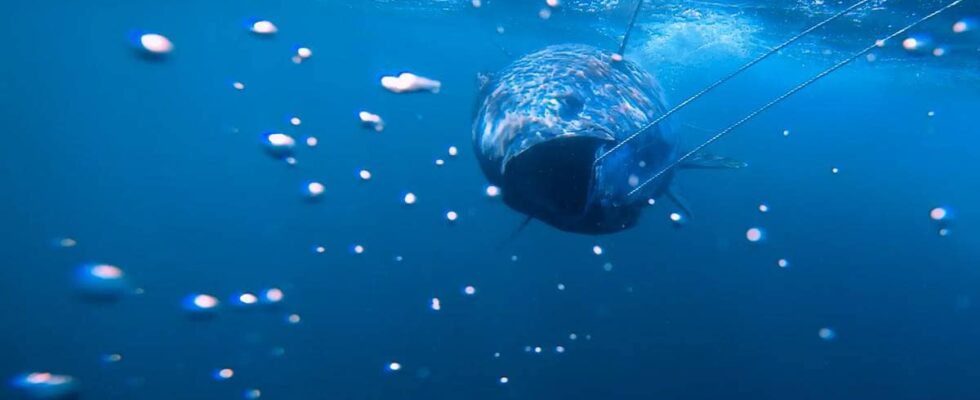Researchers at the Institute of Marine Research have mapped the movements of the mackerel sturgeon. The fish is the world’s largest tuna. They can be over three meters long and weigh up to 500 kilograms. From 2020 to 2022, the researchers put satellite tags on 25 mackerel sturgeon. Never before have mackerel sturgeon been tagged this far north. This data has now been studied, and on Wednesday the researchers will publish a new insight into how the fish they call the “torpedo of the sea” migrates. AROUND THE WORLD: The fish swam in a large area, from Cape Verde in the south to the edge of the Arctic Circle in the north. Around the world in 365 days One of the fish crossed the Atlantic Ocean twice, before it swam all the way east in the Mediterranean. A swim of 45,000 kilometers, all covered in a year. It is almost five thousand kilometers longer than the circumference of the Earth. – The mackerel sturgeon is a fantastic creature, says researcher Keno Ferter at the Institute of Marine Research. The megafish has good acceleration, with a single stroke of the tail it quickly picks up speed. Ferter calls the fish the “torpedo of the sea”. – It swims like a torpedo. Fast and efficient. But they don’t destroy anything like torpedoes, but they are just very good swimmers. They also swim far, explains Ferter. The researchers’ findings show that the mackerel sturgeon use the same routes every year. The fish have regular stops throughout the year. They swim together and find their way back to where they have been. The researchers satellite tagged 25 fish. 13 of the tags were recovered from the fish, and could provide a total of 4,699 days of high-resolution data on position, depth and temperature. Photo: Havforskningsinstituttet One of the sturgeons the researchers followed had crossed the entire Atlantic and the entire Mediterranean. 365 days later it appeared in the exact same place it had left. – I can almost say that it was an emotional experience. It was incredible. At first we thought it was a one-off. But later we got the same type of data from other sturgeons, he says. The research has been published in the international journal Proceedings of the Royal Society B: Biological Sciences. It is funded by the Atlantic Tuna Commission. The Institute of Marine Research has, among other things, worked closely with researchers from Stanford University in the USA. Master swimmers Most of the fish overwinter in the mid-Atlantic, near Canada. When spring comes, they move towards warmer areas. Then the Mediterranean is the main destination. It will spawn here. Over the summer, the “torpedo of the sea” speeds towards the Norwegian coast. Because there is a lot of good food here. Big fish need a lot of food. The megafish is fond of mackerel, and the researchers at the Norwegian Institute of Marine Research believe that the mackerel sturgeon can have an impact on other fish stocks. – We have never seen so many mackerel sturgeon as now, says skipper Jostein Hillersøy. Photo: Havforskningsinstituttet He operates the boat “Hilersøy”, which fishes for, among other things, mackerel, herring and mackerel sturgeon. They have a mackerel sturgeon quota of 50 tonnes. The boat recently caught one of the giant fish. – We need better help to sell sturgeon around the world, says Hillersøy. May affect Norwegian mackerel fishing Researcher at the Institute of Marine Research, Leif Nøttestad, tells news that the mackerel sturgeon in Europe and Asia is part of a billion-dollar industry. Especially in Japan, this fish is very popular. He believes that mackerel sturgeon is a good natural resource for Norway. On the other hand, the increased stock can bring problems. Skipper Hillersøy says he has experienced that the mackerel sturgeon population has increased sharply in the last six to seven years. He believes the increased stock is starting to become a problem. – They eat an enormous amount of small mackerel. We find 20 kilos of herring and mackerel in the stomachs of the sturgeons, says Hillersøy. Nøttestad at the Institute of Marine Research says that the mackerel sturgeon can have an indirect effect on Norwegian mackerel fishing. – The sturgeon is a top predator that feeds on other species. It is part of the ecosystem. But it can happen that the mackerel sturgeon eat too much of the mackerel, says Nøttestad. Friends of Norway The researchers at the Institute of Marine Research have found that the mackerel sturgeon arrive in Norwegian waters in mid-August and stay until mid-October. The researchers go out to catch the mackerel sturgeon in order to tag them. Photo: Norwegian Institute of Marine Research On average, the “torpedo of the sea” visits the Norwegian coast for 68 days. Some sturgeons swim as far north as Brønnøysund. But most stay in the areas between Ålesund and Lindesnes. The new research means that the large mackerel sturgeon are more easily available for a targeted fishery. In the 50s and 60s, a lot of mackerel sturgeon was fished in Norway. But then there was overfishing and the stock declined. – It is only in the last 10-15 years that the mackerel sturgeon has returned to Norwegian waters. It’s a fantastic “comeback”, says Ferter. The researcher explains that when the stock gets bigger, they come further north. Published 09.10.2024, at 05.54
ttn-69
Researchers have mapped the mackerel sturgeon’s movements – news Vestland

